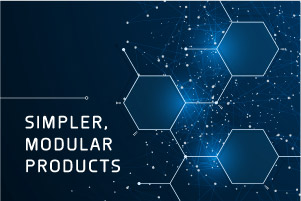How COVID-19 is changing future innovation in healthcare and life sciences.
Healthcare and life science companies’ response to the pandemic has been nothing short of awe-inspiring. By challenging traditional thinking and processes, companies have been able to collapse healthcare product development and delivery timelines to get everything from diagnostic tests to life-saving medical devices out the door in large volumes and at record speeds.
This herculean effort has saved lives. But it also prompts a question: Was this massive mobilization of resources just a one-time response to a once-in-a-lifetime pandemic? Or have things permanently changed?
For some healthcare and life science companies, and the design, development and manufacturing partners who work with them, there is no question. The pandemic has sparked a permanent change to how they approach healthcare product development.
These companies aren’t content with the old ways of doing things. Instead, they’re thinking differently about healthcare and medical device product development, and looking to build on the advances made in the last two years.
These companies are focusing their efforts on key needs and improvement opportunities like:
1. Improved supply chain planning
 Supply chain constraints have been a major challenge during the pandemic. In some cases, they’ve forced companies to redesign products — and as a result go through testing and FDA approval processes all over again — at the 11th hour of a product launch.
Supply chain constraints have been a major challenge during the pandemic. In some cases, they’ve forced companies to redesign products — and as a result go through testing and FDA approval processes all over again — at the 11th hour of a product launch.
We’ve always urged our customers to bring supply chain into the conversation at the earliest stages. Now, medtech companies have seen an outsized example of just how critical it can be to address supply chain needs proactively in the design process. For example, looking ahead to where products will be built allows a product development team to make design choices with a better line of sight to the supply chain constraints they might face in that region. Companies are forecasting based on not only demand but also supply — it’s not a given that the supply will be there to meet their product’s demand. And they’re taking new precautions in the design process, like performing supply-chain checks on individual parts before designing them into the product — or even buying parts the team thinks might be needed to ensure that they’re available if they become part of the completed product design.
In some cases, medical device manufacturers are developing multiple design options for one product as a way to protect against supply chain risks. This may result in higher overhead, but if it’s a decision of greater cost or having no product to ship at all, this beats the alternative.
2. Shorter design cycles
 The rapidly spreading pandemic demanded faster ways of working to get medical devices, diagnostic testing equipment and other critically needed products to providers and patients as quickly as possible. By necessity, manufacturers had to find ways to speed up processes and accelerate innovation.
The rapidly spreading pandemic demanded faster ways of working to get medical devices, diagnostic testing equipment and other critically needed products to providers and patients as quickly as possible. By necessity, manufacturers had to find ways to speed up processes and accelerate innovation.
Now, many of those companies are looking to make faster product delivery the common practice.
As we saw during the pandemic, this isn’t simply a matter of uncovering efficiency gains in existing processes. To move faster and meet needs more rapidly, companies need to be willing to rethink how they’ve traditionally done things. One example is the traditional workflow for healthcare product prototyping. Companies often only perform reliability testing on a product after they’ve developed the prototype and submitted it for clinical testing. During the pandemic, waiting for a completed prototype often wasn’t an option. Instead, some companies had to identify the mechanisms that would be used in the product design and perform reliability testing on those mechanisms individually before completing the prototype. As supply chain constraints continue to be an issue, this is a practice that seems to be sticking around.
3. Simpler, modular products
 Trying to get a device to market faster can also force you to simplify the product’s design. For some companies, that has meant shifting their design focus from products that solve a single, specific need to modular platforms that can address a wide range of needs.
Trying to get a device to market faster can also force you to simplify the product’s design. For some companies, that has meant shifting their design focus from products that solve a single, specific need to modular platforms that can address a wide range of needs.
For example, the pandemic created widespread, urgent demand for rapid, accurate testing. Some companies were able to respond by developing new assays for existing point-of-care diagnostic devices. This and other modular approaches can shorten time to market, because the analyzer itself is a general-purpose device that can be adapted to multiple use cases. When new uses come along, it’s only a matter of developing the new assay (or other modular element), rather than designing a new product from the ground up.
When you need to get your product to market faster, you need to find the simplest path to get there. That can mean streamlining the design to reduce dependency on individual parts. The other advantage of simplifying the product comes with focusing design efforts on usability. Simpler, easier-to-use products benefit the end user with a smoother experience that’s more straightforward and less prone to error.
All of this requires a change in mindset toward a systems engineering approach. It’s less about building a product that supports numerous functions, and more about clearly understanding the needs for the product in the marketplace, then designing the simplest, shortest path to meet those needs.
An industrywide catalyst for innovation in healthcare and life sciences.
Some changes that can improve post-pandemic healthcare innovations are bigger than one company or one kind of product.
For instance, greater supply chain integration has the potential to lessen the impact of future disruptions and help make the supply chain more efficient for the entire industry. But it will require everyone, from raw-material suppliers to component and sub-assembly providers, to manufacturers and co-manufacturers, to better communicate and coordinate their activities, so everyone can gain better visibility into the supply chain and have a more efficient flow of materials.
Progress is already being made on this effort at a grassroots level. But it will take time — and broader industry support — for this effort to take hold at a systemic level. Until then, healthcare and life sciences companies have no shortage of opportunities to make their product development and engineering processes more agile, efficient and lower risk. The right partner can provide the expertise, support and global resources to build your idea into an industry-leading healthcare device or life science instrument.
Ready to rethink your healthcare or life science product development? Our team of industry experts are available to lend insights and talk possibilities. Plexus takes pride in helping partners across the healthcare and life sciences industry work smarter. Get in touch with our team today so we can understand your needs and provide guidance on how we can partner to bring your vision to life.



